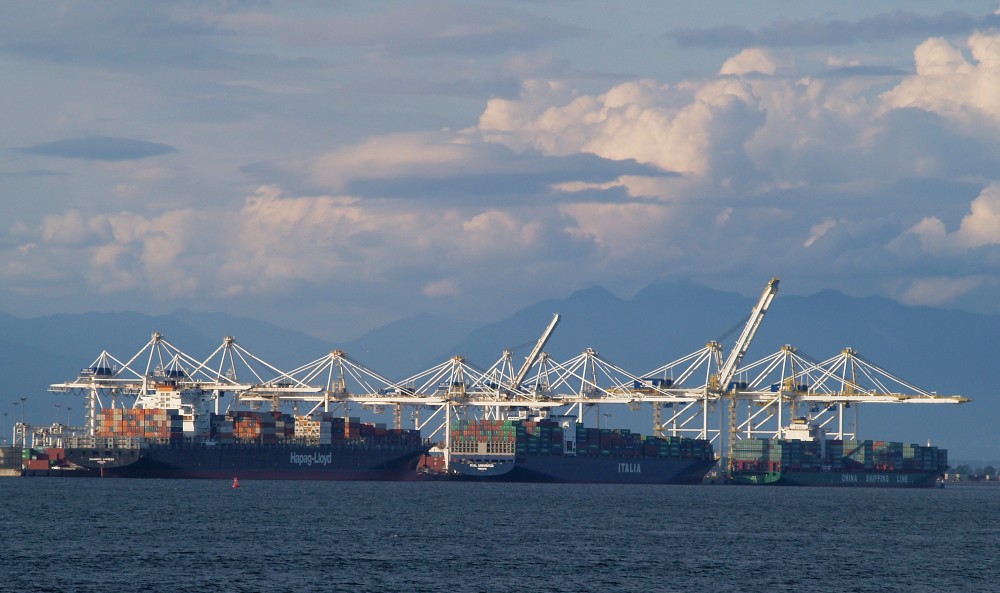Supreme Court Decision Shows Path Forward for National Plan to Reduce Maritime Sector Emissions
Container ships docked near Vancouver, BC.
Crédit : Craig Bennett/Flickr
Last week, the Supreme Court of Canada made a major decision: In a 6-3 ruling, the justices found that the federal government has the constitutional authority to set a minimum price on greenhouse gas (GHG) emissions.
While the ideas at issue may seem abstract, the real-life consequences are huge. By the end of the century, for example, the Arctic could face a staggering 12-degree increase in temperature due to climate change. That’s why Oceans North intervened in the hearing in support of the federal government’s jurisdiction to regulate greenhouse gas emissions. The recent decision puts an end to years of litigation, and it ensures that Canada can move forward with a national strategy for reducing emissions that spurs innovation and provides benefits for the entire country.
The provinces involved in the challenge argued that they should be able to regulate emissions as they saw fit. Unfortunately, carbon emissions—and the resulting impacts on the climate—don’t stop at provincial borders. The Arctic and the oceans have already been feeling the effects: excess CO2 absorbed by the oceans is causing acidification, and the sea ice that many Inuit communities rely on for travel and hunting has become more dangerous as the Arctic warms.
One of the main reasons that Oceans North intervened in the hearing on the Greenhouse Gas Pollution Pricing Act was to ensure that the impact of GHG emissions and climate change in the Arctic marine environment were fully considered by the court. Our message was heard. Writing the decision for the majority, Justice Wagner noted that unless emissions are reduced, climate change will cause “significant environmental, economic and human harm nationally and internationally, with especially high impacts in the Canadian Arctic, in coastal regions and on Indigenous Peoples.” The decision also details the fact that Canadian waters are experiencing “changes in relative sea level and rising water temperatures, as well as increased ocean acidity and loss of sea ice and permafrost.”
Now that the question of whether we can have a truly national approach to fighting climate change is finally settled, the next step is to work on the details of the plan. The federal government has already put forward many promising policies and pieces of legislation that will incentivize the development and deployment of zero-emission fuels and renewable energy.
One promising avenue that Oceans North has been exploring as part of the solution to reduce emissions is the use of hydrogen fuels in Canadian ports, vessels and the shipping industry. The shipping industry accounts for more than 80% of world trade and produces more than one billion tonnes of greenhouse gas emissions per year—more than any but the top-five emitting countries. Without additional measures in place, shipping will represent 10 percent of global greenhouse gas emissions by 2050. At the Port of Vancouver, for example, emissions are set to rise with increased trade. Taking steps to reduce shipping emissions will therefore be vital to reaching our global targets and fighting climate change.
As a fuel that can be produced and burned with little to no GHG emissions, hydrogen is an important pathway to mitigate the maritime sector’s emissions. Canada has both the expertise and the resources to become a leader in the burgeoning hydrogen economy and help lead the transition to cleaner shipping, but the path forward requires guidance from a strong federal framework, with regulations and incentives that address the unique challenges of the port and maritime sector. To that end, Oceans North is convening the first-of-its-kind Ports & Maritime Hydrogen Summit Series: three meetings from coast to coast that are bringing together thought leaders, industry experts and government leaders from across Canada to discuss the use of hydrogen in ports and the maritime industry.
There’s no single, magical solution that will appear to get us to net-zero emissions. The road to net-zero by 2050 requires the same kind of energetic dedication to purpose that built this country in the first place. This time, however, we have to reverse the impact that our actions are having on the terrestrial and ocean environment, Indigenous peoples and the welfare of all future generations. We need to come together as a country and use our collective will, ingenuity and vision to achieve the environmental and economic outcomes we need to secure our future—and that requirement must know no boundary. The Supreme Court ruling has cleared the runway to begin the hard work that is needed over the next 10 years to set Canada on the pathway to net-zero emissions.
Brent Dancey is Oceans North’s director of marine climate action.





